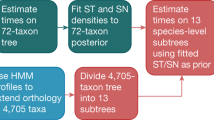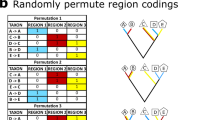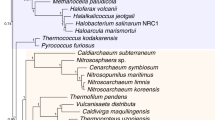Abstract
Divergence times estimated from molecular data often considerably predate the earliest known fossil representatives of the groups studied. For the order Primates, molecular data calibrated with various external fossil dates uniformly suggest a mid-Cretaceous divergence from other placental mammals, some 90 million years (Myr) ago1,2,3,4,5,6,7,8,9, whereas the oldest known fossil primates are from the basal Eocene epoch (54–55 Myr ago). The common ancestor of primates should be earlier than the oldest known fossils10,11, but adequate quantification is needed to interpret possible discrepancies between molecular and palaeontological estimates. Here we present a new statistical method, based on an estimate of species preservation derived from a model of the diversification pattern, that suggests a Cretaceous last common ancestor of primates, approximately 81.5 Myr ago, close to the initial divergence time inferred from molecular data. It also suggests that no more than 7% of all primate species that have ever existed are known from fossils. The approach unites all the available palaeontological methods of timing evolutionary events: the fossil record, extant species and clade diversification models.
This is a preview of subscription content, access via your institution
Access options
Subscribe to this journal
Receive 51 print issues and online access
$199.00 per year
only $3.90 per issue
Buy this article
- Purchase on Springer Link
- Instant access to full article PDF
Prices may be subject to local taxes which are calculated during checkout


Similar content being viewed by others
References
Janke, A., Feldmaier-Fuchs, G., Thomas, W. K., von Haeseler, A. & Pääbo, S. The marsupial mitochondrial genome and the evolution of placental mammals. Genetics 137, 243–256 (1994).
Easteal, S., Collett, C. & Betty, D. The Mammalian Molecular Clock (Landes, Austin, 1995).
Hedges, S. B., Parker, P. H., Sibley, C. G. & Kumar, S. Continental breakup and the ordinal diversification of birds and mammals. Nature 381, 226–229 (1996).
Springer, M. S. et al. Endemic African mammals shake the phylogenetic tree. Nature 388, 61–64 (1997).
Arnason, U., Gullberg, A. & Janke, A. Molecular timing of primate divergences as estimated by two nonprimate calibration points. J. Mol. Evol. 47, 718–727 (1998).
Huelsenbeck, J. P., Larget, B. & Swofford, D. A compound Poisson process for relaxing the molecular clock. Genetics 154, 1879–1892 (2000).
Madsen, O. et al. Parallel adaptive radiations in two major clades of placental mammals. Nature 409, 610–614 (2001).
Murphy, W. J. et al. Molecular phylogenetics and the origins of placental mammals. Nature 409, 614–618 (2001).
Eizirik, E., Murphy, W. J. & O'Brien, S. J. Molecular dating and biogeography of the early placental mammal radiation. J. Hered. 92, 212–219 (2001).
Martin, R. D. Primate origins: plugging the gaps. Nature 363, 223–234 (1993).
Martin, R. D. in Major Topics in Primate and Human Evolution (eds Wood, B. A., Martin, L. B. & Andrews, P.) 1–31 (Cambridge Univ. Press, Cambridge, 1986).
Marshall, C. R. in The Adequacy of the Fossil Record (eds Donovan, S. K. & Paul, C. R. C.) 23–53 (Wiley, London, 1998).
Harris, T. E. The Theory of Branching Processes (Springer, Berlin, 1963).
Nee, S., May, R. M. & Harvey, P. H. The reconstructed evolutionary process. Phil. Trans. R. Soc. Lond. B 344, 305–311 (1994).
Raup, D. M., Gould, S. J., Schopf, T. M. & Simberloff, D. S. Stochastic models of phylogeny and the evolution of diversity. J. Geol. 81, 525–542 (1973).
MacArthur, R. H. & Wilson, E. O. An equilibrium theory of insular zoogeography. Evolution 17, 373–387 (1963).
MacArthur, R. H. & Wilson, E. O. The Theory of Island Biogeography (Princeton Univ. Press, Princeton, New Jersey, 1967).
Sepkoski, J. J. Jr A kinetic model of Phanerozoic taxonomic diversity: I. Analysis of marine orders. Paleobiology 4, 223–225 (1978).
Alroy, J. in Biodiversity Dynamics (eds McKinney, M. L. & Drake, J. A.) 232–287 (Columbia Univ. Press, New York, 1998).
Foote, M., Hunter, J. P., Janis, C. M. & Sepkoski, J. J. Jr Evolutionary and preservational constraints on origins of biological groups: divergence times of eutherian mammals. Science 283, 1310–1314 (1999).
Foote, M. & Sepkoski, J. J. Absolute measures of the completeness of the fossil record. Nature 398, 415–417 (1999).
Alroy, J. Cope's rule and the dynamics of body mass evolution in North American fossil mammals. Science 280, 731–733 (1998).
Alroy, J. Quantitative mammalian biochronology and biogeography of North America. PhD dissertation. Univ. Chicago (1994).
Gingerich, P. D. & Uhen, M. D. Time of origin of primates. J. Hum. Evol. 27, 443–445 (1994).
Foote, M. Estimating taxonomic durations and preservation probability. Paleobiology 23, 278–300 (1997).
Martin, R. D. Primate Origins and Evolution: A Phylogenetic Reconstruction (Chapman Hall/Princeton Univ. Press, London/New Jersey, 1990).
Davison, A. C. & Hinkley, D. V. Bootstrap Methods and their Applications (Cambridge Univ. Press, Cambridge, 1997).
Wolfheim, J. H. Primates of the World: Distribution Abundance and Conservation (Univ. Washington Press, Seattle/London, 1983).
Acknowledgements
We thank U. Arnason, A. Müller and U. Thalmann for helpful comments on the manuscript.
Author information
Authors and Affiliations
Corresponding author
Ethics declarations
Competing interests
The authors declare that they have no competing financial interests
Supplementary information
Rights and permissions
About this article
Cite this article
Tavaré, S., Marshall, C., Will, O. et al. Using the fossil record to estimate the age of the last common ancestor of extant primates. Nature 416, 726–729 (2002). https://doi.org/10.1038/416726a
Received:
Accepted:
Issue Date:
DOI: https://doi.org/10.1038/416726a
This article is cited by
-
Nonhuman primate genetic models for the study of rare diseases
Orphanet Journal of Rare Diseases (2023)
-
The pioneering role of PRDM9 indel mutations in tarsier evolution
Scientific Reports (2016)
Comments
By submitting a comment you agree to abide by our Terms and Community Guidelines. If you find something abusive or that does not comply with our terms or guidelines please flag it as inappropriate.



